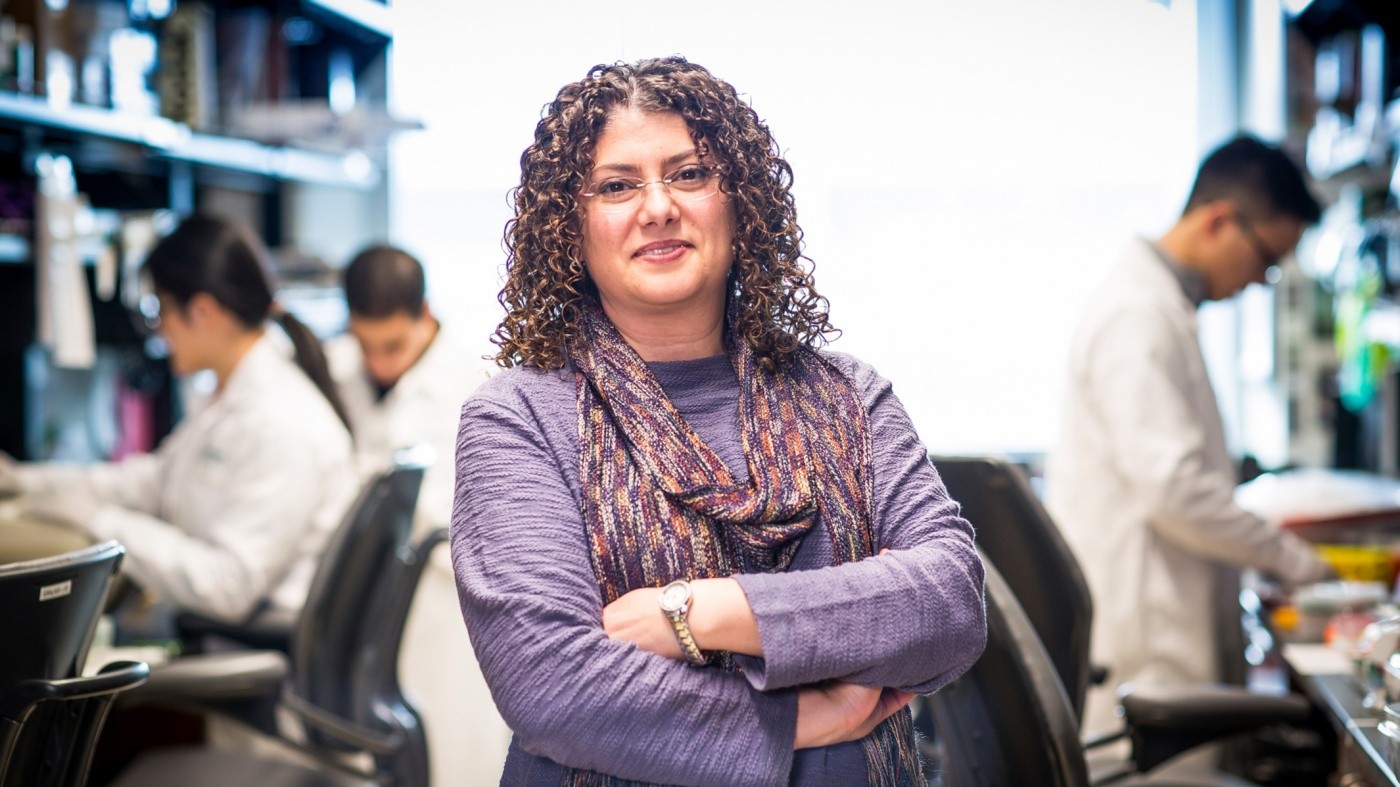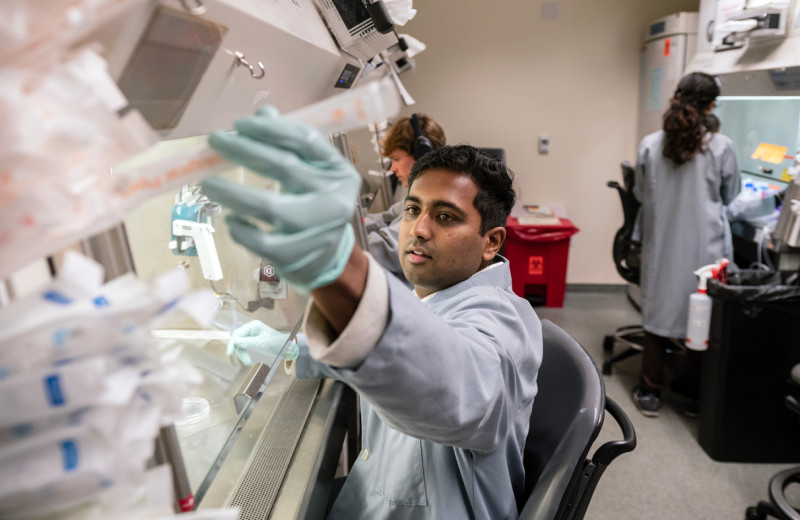Gladstone NOW: The Campaign Join Us on the Journey✕

Shomyseh Sanjabi and her team show that different routes of sexual transmission affect how a virus spreads through the body. [Photo: Elisabeth Fall]
A person is more likely to get infected by HIV through anal intercourse than vaginal, but no one knows quite why. A new study by scientists at the Gladstone Institutes shows that infection sites could affect the immune system’s response to a virus and the way the virus spreads through the body.
The study, published in Mucosal Immunology, aimed to understand how the immune system responds to a virus when it enters the body through different points. The researchers focused particularly on common routes of sexual transmission of viruses, such as the lower female reproductive tract and the lower gastrointestinal tract that includes the large intestine and the anus.
These mucosal barriers—the body’s openings lined with a membrane called mucosa—are responsible for distinguishing between harmless bacteria that normally reside in us and potentially dangerous pathogens, as well as other substances, such as food or sperm.
“Our body is constantly trying to balance between tolerating harmless elements and defending us against possible threats,” said Shomyseh Sanjabi, PhD, assistant investigator at Gladstone who led the study. “We wanted to learn whether the mechanisms that allow the body to be tolerant would affect its ability to elicit a protective immune response when needed. And, whether the process was different depending on the virus’s point of entry.”
Sanjabi’s team discovered that, in fact, the body’s reaction is different based on the infection site. They showed that the vaginal and rectal cavities activate a distinct immune response to the same pathogen.
Differences between Natural Routes of Infection
To conduct the study, Sanjabi and her team created a new model of viral infection through the rectum that uses lymphocytic choriomeningitis virus (LCMV), a rodent virus often used in research to model other pathogens. They then compared their findings to their previous work on vaginal infection by LCMV.
In 2016, they showed that vaginal infection causes a delayed response by protective cells. As a result, the immune system takes longer to clear the virus from the female reproductive tract. They also noticed that the virus stayed in the vagina and didn’t spread to other parts of the body.
In contrast, the new study indicates that, after infection through the rectum, the virus rapidly spreads throughout the body. The scientists also found that the virus wasn’t being carried through the blood. Instead, LCMV infects the body’s own immune cells, which in turn spread the virus systemically. Interestingly, this is the same dissemination process used by the HIV virus.
“Our group was the first to recreate and compare these natural routes of viral infection,” said Martin Trapecar, PhD, first author of the study and former postdoctoral scholar in Sanjabi’s laboratory at Gladstone. “We concluded that the initial immune response elicited depends on the route of infection, and can actually dictate the dissemination of the virus. This is a novel concept, because we used to think once the virus entered the body, it would simply get into the blood and spread.”
The researchers revealed that mucosal barriers have different tolerance mechanisms that affect the immune system’s response to invading pathogens. In addition, they showed that once a virus breaches one of the barriers, early events in the body’s response to that virus can play a key role in determining the outcome of an infection.
New Insights to Study and Prevent Viruses
The new study provides a much better understanding of how the immune system responds to a pathogen to protect the body and how a virus spreads once it enters the vaginal or rectal mucosa. These findings have general implications for the mechanism of sexual transmission and dissemination of many viruses, including HIV and Zika.
“Knowing the route each virus takes when it infects people is important,” said Sanjabi, who is also an assistant professor of microbiology and immunology at UC San Francisco. “Our findings could change the way other scientists study viruses, and might ultimately be key to targeting treatments.”
Results from Sanjabi’s study could also impact efforts to develop vaccines against various viruses. Recognizing the differences in immune response will be crucial to defend people who may get infected through various routes of sexual transmission.
About the Study
Other authors include Frank Wu, research associate in Sanjabi’s laboratory, and former Gladstone trainees Shahzada Khan and Benjamin Cohn. The research was supported by the National Institutes of Health, the Hellman Fellows Fund, the UCSF-Gladstone Center for AIDS Research (CFAR), and the Creative and Novel Ideas in Research (CNIHR) Program.
For Media
Julie Langelier
Associate Director, Communications
415.734.5000
Email
About Gladstone Institutes
Gladstone Institutes is an independent, nonprofit life science research organization that uses visionary science and technology to overcome disease. Established in 1979, it is located in the epicenter of biomedical and technological innovation, in the Mission Bay neighborhood of San Francisco. Gladstone has created a research model that disrupts how science is done, funds big ideas, and attracts the brightest minds.
Support Discovery Science
Your gift to Gladstone will allow our researchers to pursue high-quality science, focus on disease, and train the next generation of scientific thought leaders.
Genomic Maps Untangle the Complex Roots of Disease
Genomic Maps Untangle the Complex Roots of Disease
Findings of the new study in Nature could streamline scientific discovery and accelerate drug development.
News Release Research (Publication) Marson Lab GenomicsSix Gladstone Scientists Named Among World’s Most Highly Cited Researchers
Six Gladstone Scientists Named Among World’s Most Highly Cited Researchers
The featured scientists include global leaders in gene editing, data science, and immunology.
Awards News Release Corces Lab Doudna Lab Marson Lab Pollard Lab Ye LabThe Genome Editing Playbook Is Different in Neurons
The Genome Editing Playbook Is Different in Neurons
The striking findings of a new study could influence how gene therapies are designed for many genetic diseases.
News Release Research (Publication) Neurological Disease Conklin Lab Doudna Lab CRISPR/Gene Editing



